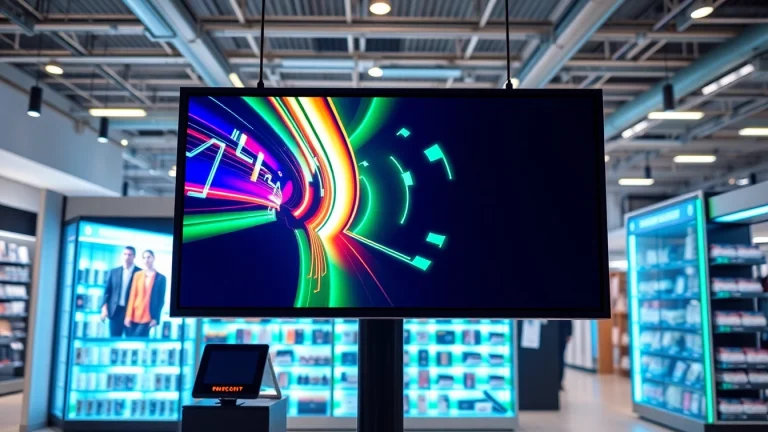
Maximize Visibility with the Fire TV Digital Signage App: A Guide to Effective Implementation
Understanding Digital Signage
What is Digital Signage?
Digital signage refers to the use of digital displays to communicate information, marketing messages, and interactive content to an audience. These displays can be found in various public spaces such as retail stores, transportation hubs, corporate offices, and educational institutions. Unlike traditional signage, digital signage is dynamic and can be updated in real time over the internet, allowing for flexibility in content management and enhanced engagement with viewers.
Benefits of Digital Signage
Implementing digital signage brings numerous advantages, making it a popular choice for many businesses today. Here are some key benefits:
- Enhanced Engagement: Digital displays attract attention more effectively than static signs. Dynamic content such as videos, animations, and real-time updates can engage viewers and encourage interaction.
- Flexibility and Instant Updates: With digital signage, businesses can change their messaging instantly, whether promoting a flash sale, updating timetables, or sharing event information without needing to print new materials.
- Cost-Effectiveness: Over time, digital signage can be more economical than traditional signage, which involves recurring printing and installation costs. The ability to renew content without additional materials contributes to savings.
- Targeted Messaging: Digital signage can be programmed to display specific content based on the time of day, audience demographics, or location, allowing for tailored marketing strategies.
- Improved Communication: In environments like offices or schools, digital signage facilitates effective communication by displaying important announcements, schedules, and alerts in real time.
Fire TV Digital Signage App Overview
The Fire TV digital signage app is a powerful tool that utilizes the Amazon Fire TV platform to display digital signage content efficiently. This app allows users to turn any TV equipped with a Fire TV stick into an information display or advertising platform without the need for elaborate setups. The accessibility and ease of installation make it an appealing choice for businesses of all sizes, from small cafes to large corporations.
Setting Up Your Fire TV Digital Signage App
Device Compatibility and Requirements
Before diving into installation, it’s crucial to ensure that your hardware meets the requirements for using a Fire TV digital signage app. Here’s what you need:
- Compatible Device: You will need a compatible Amazon Fire TV device, such as the Fire Stick or Fire TV, connected to your display.
- Internet Connection: A stable and reliable internet connection is essential for streaming content and updates.
- Digital Signage App: Identify and download a suitable digital signage app from the Amazon App Store that meets your business needs. Apps like AbleSign or PlaySignage are popular choices.
- Content Sources: Prepare your content sources, which could include images, videos, and HTML-based content that you wish to display.
Installation Steps for the Fire TV Digital Signage App
Installing the Fire TV digital signage app is a straightforward process. Follow these steps:
- Ensure your Fire TV device is powered on and connected to your display.
- Navigate to the Amazon App Store on your Fire TV interface.
- Search for the chosen digital signage app and select it for download.
- Once installed, open the app, and follow the on-screen instructions to set up your account or connect to existing accounts.
- Authenticate your app by entering any required credentials and connect it to your content management system if applicable.
Initial Configuration and Setup
Upon successful installation, configure the app to fit your specific needs:
- Layout Design: Choose or customize the layout templates available within the app. This will dictate how your content appears on the screen.
- Content Upload: Upload the various contents you prepared, such as images or videos, and arrange them within the layout.
- Scheduling: Utilize any scheduling features of the app to determine when certain content will display based on time or audience demographics.
- Testing: Once configuration is complete, conduct a test run to ensure content appears correctly and the app functions as expected.
Creating Compelling Content
Types of Content for Digital Signage
Content is at the heart of any digital signage strategy. Various types of content can be utilized, depending on your goals and audience:
- Promotional Videos: Create engaging video clips that showcase products, services, or special offers.
- Static Images: High-quality images can be used for announcements, menu displays, or branding purposes.
- Textual Content: Simple text displays can be used to convey messages, quotes, or real-time data such as news headlines.
- Interactive Content: Incorporate QR codes or links that enable customers to take action directly from the display, driving engagement.
- Social Media Feeds: Dynamically display content from social media platforms to showcase user-generated content and engage with your audience.
Design Tips for Engaging Displays
The effectiveness of your digital signage is largely determined by its design. Here are some tips to create captivating displays:
- Keep It Simple: Avoid clutter. Use clear, concise messages. Simplicity allows viewers to absorb information quickly.
- Use High Contrast: Choose colors that contrast well with each other to improve visibility and readability.
- Limit Text: Aim for short sentences or bullet points. The attention span of viewers is short; keep content digestible.
- Include Call-to-Actions: Encourage viewer interaction with engaging prompts or incentives to act on specific information.
- Maintain Brand Consistency: Utilize consistent fonts, colors, and logos that reflect your brand identity for cohesive messaging.
Best Practices for Content Scheduling
Effective content scheduling can maximize viewer engagement. Consider the following best practices:
- Regular Updates: Refresh your content regularly to keep it relevant and exciting for repeat viewers.
- Optimal Timing: Assess the best times for certain content based on your audience’s behavior and foot traffic patterns.
- A/B Testing: Experiment with different types of content and formats to identify what resonates best with your audience.
- Seasonal Promotions: Align your content scheduling with seasonal events, holidays, or local happenings to capture audience interest.
Performance Metrics and Analysis
Tracking Viewer Engagement
Understanding how your digital signage performs is crucial for ongoing improvement. Utilize various metrics to gauge viewer engagement, such as:
- View Duration: Measure how long viewers stay engaged with your content.
- Interaction Rates: If utilizing interactive displays, track how often viewers interact with the content.
- Foot Traffic Correlation: Analyze changes in foot traffic before and after digital signage implementation to assess impact.
- Feedback Mechanisms: Setup surveys or feedback channels to gather viewer opinions on your digital signage content.
Evaluating Content Effectiveness
Beyond initial engagement metrics, it’s essential to evaluate the overall effectiveness of your content:
- Sales Correlation: Track if specific promotions displayed through digital signage directly lead to sales increases.
- Brand Awareness Impact: Utilize market research tools to assess any shifts in brand awareness linked to your digital signage.
- Content Popularity: Regularly analyze which pieces of content generate the most engagement to guide future content strategies.
Continuous Improvement Strategies
Digital signage is not a one-time setup but an evolving project. Implement continuous improvement strategies such as:
- Regular Review: Continually review engagement metrics and feedback to refine your content strategy.
- Staying Updated: Keep up with digital signage trends and technology to ensure your approach remains current.
- Soliciting Team Input: Engage your team to provide insights and suggestions based on their experience and customer feedback.
Expanding Your Digital Signage Network
Integrating Additional Devices
As your business grows, so can your digital signage network. Consider integrating additional devices to enhance reach and engagement:
- Multiple Screens: Roll out additional screens in strategic locations to capture broader audiences across different environments.
- Mobile Integration: Explore integrating mobile capabilities where users can engage with content directly from their devices.
- Remote Management Systems: Utilize centralized platforms that can manage content across all devices, saving time and ensuring consistency.
Scaling Your Digital Signage Setup
When scaling up your digital signage opportunities, keep the following strategies in mind:
- Adopting a Modular Approach: Start with a few screens and gradually integrate more as needed. This will help manage costs and complexity.
- Cloud-Based Solutions: Consider cloud platforms that allow you to scale your network without extensive hardware investments.
- Training: Equip your staff with necessary training for managing expanded digital signage setups efficiently.
Future-Proofing Your Digital Signage Strategy
As technology continues to evolve, future-proofing your digital signage strategy is essential:
- Adaptable Technology: Choose solutions that easily adapt to future software updates or hardware upgrades.
- Consumer Trends: Stay informed and responsive to changing consumer behaviors to adjust your messaging accordingly.
- Data-Driven Decisions: Utilize data analytics to steer your approach and make informed choices regarding content and dissemination strategies.


